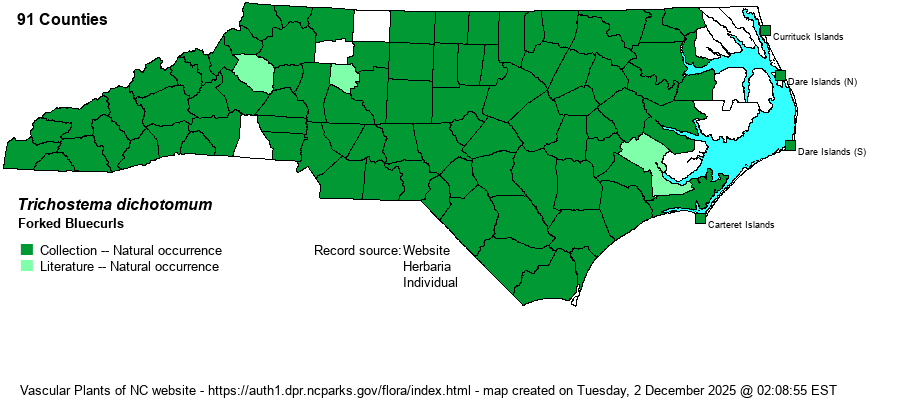| Author | L. | |
| Distribution | Occurs statewide, though possibly absent from the mainland of a few eastern Coastal Plain counties (it is present on the Outer Banks).
This is an Eastern species, ranging from eastern Canada south to the Gulf Coast. | |
| Abundance | Common across the Piedmont and the western, central, and southern Coastal Plain, including the Sandhills. Frequent to common in the Mountains. Fairly common along coastal islands, but scarce in the northeastern counties inward from the coast. Why the NCNHP has its State Rank at S4 is a complete mystery, considering that it has been recorded from at least 88 counties and is practically common statewide. | |
| Habitat | This is a species of dry to somewhat dry openings and edges. It occurs along wooded borders, old fields, powerline clearings, meadows, edges of outcrops, and various other often grassy places, include dunes. | |
| Phenology | Blooms from August to frost, and fruits soon after flowering. | |
| Identification | This is a much -branched herb of medium height, growing to about 1.5 feet tall. It has numerous opposite leaves that are generally elliptical to lanceolate, about 2 inches long and about 3/4-inch wide, the base tapering to a point, and generally entire margins. From the axils of the leaves on the branches (which tend to be stiff and ascending) grow a single medium-sized flower, violet-blue with some white. The four upper lobes curl upland, and the very long bottom lobe is strongly curved downward like a tongue, with the tip violet-blue but the basal part white with violet spots. The 4 stamens are very long and curl downward just below the upper lip, to produce a flower like a dragon's-mouth. This is certainly a favored wildflower in the very late summer and fall seasons owing to the deep blue flowers with an odd "architecture"! Thankfully, it is often seen at that time of year. | |
| Taxonomic Comments | None, though it is likely that the undescribed species was included within it when RAB (1968) was published, though there was no mention of this odd taxon in the reference.
| |
| Other Common Name(s) | Common Bluecurls, Blue-curls (not sufficient, as there are several species) | |
| State Rank | S4 [S5] | |
| Global Rank | G5 | |
| State Status | | |
| US Status | | |
| USACE-agcp | UPL link |
| USACE-emp | UPL link |

